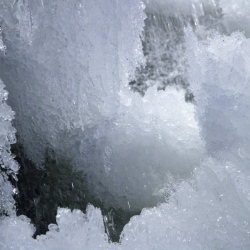
Some bacteria love the cold so much that they can actually cause ice to form. A species called Pseudomonas syringae, a plant pathogen, is responsible for frost damage to crops, and is so good at nucleating ice crystals around itself that it’s used to generate artificial snow for ski resorts.
Scientists have long known that P. syringae plays an important role in biology and atmospheric science, because it can form ice at temperatures above freezing. But until now, researchers have never taken a close look at what goes on right at the border between a bacterium and water, as it gets turned into ice. Using detailed imaging tools, researchers have looked at the specific proteins in the cell membrane to understand how it creates a lattice on which ice can form. They published a study with their findings today in the journal Science Advances.
The researchers used a technique called sum frequency generation spectroscopy, which uses a complex array of lasers pointed at a sample to detect the interface between a sample and a solution. Analyses with that tool revealed that P. syringae uses proteins in its cell membrane to slightly change the position of nearby water molecules so that they would fit more neatly into a lattice, as they are in ice.
The bacterium can then use vibrational energy to remove heat from the area around it, coalescing the water molecules into solid ice. It does all this very efficiently, the researchers write, P. syringae is perfectly evolved to cause ice to form. Antifreeze proteins in the cell membrane protect the bacteria from damage while this is happening.
These discoveries on the tiniest scale could have big implications for the planet’s hydrologic cycle and climate. P. syringae possesses such unique molecular features, the researchers write, that it might play a larger role in these global processes than was previously thought. That’s important because P. syringae has mostly been studied as a plant pathogen, not as a key player in global precipitation.
